is iron or steel stronger
Is Iron or Steel Stronger?
When discussing the strength and durability of metals, two materials often come into the conversation iron and steel. Both have played significant roles in the development of human civilization, from ancient tools and weapons to modern construction materials. However, the question of whether iron or steel is stronger does not have a straightforward answer, as it depends on several factors ranging from composition to intended use.
Understanding Iron and Steel
Firstly, it is important to distinguish between iron and steel. Iron is a pure metal that is relatively soft and malleable. It is typically found in nature, usually in the form of iron ore, and can be extracted through various smelting processes. The two most common forms are wrought iron and cast iron. Wrought iron is known for its ductility and resistance to corrosion, while cast iron is known for its brittleness but has a much higher carbon content, which gives it unique casting properties.
On the other hand, steel is an alloy that primarily consists of iron and carbon. The addition of carbon, often in varying amounts, significantly enhances iron's properties. The carbon content in steel typically ranges from 0.2% to 2.1%. This small addition makes steel considerably stronger than pure iron. Other alloying elements, such as manganese, nickel, and chromium, can also be included in steel production, further improving its mechanical properties and resistance to corrosion.
The Strength of Steel
Steel's strength is one of its most notable advantages over iron. When subjected to tensile stress, steel has higher tensile strength, which means it can withstand greater forces without breaking. This is critical in construction and manufacturing applications, where structural integrity is paramount. For instance, steel is routinely used for beams in skyscrapers and bridges because it can support heavy loads while maintaining its shape and form.
Moreover, steel's ductility allows it to bend or stretch under pressure without fracturing, making it an ideal choice for applications requiring materials that can endure dynamic loads. This is why areas that experience significant stress, like seismic zones, often utilize steel frameworks in buildings.
is iron or steel stronger

The Role of Carbon
The carbon content in steel plays a crucial role in its mechanical properties. Low-carbon steels are more malleable and can be easily molded or shaped, whereas higher-carbon steels, while harder and stronger, are more brittle. This trade-off is fundamental in choosing the appropriate type of steel for specific applications. The versatility of steel can be further optimized by heat treatment processes, which can enhance hardness and toughness.
Applications and Real-World Implications
In contemporary contexts, steel has largely taken precedence over iron due to its superior strength-to-weight ratio and versatility. For instance, in the automotive industry, manufacturers prefer steel for bodies and frames, as it provides the necessary strength while remaining relatively lightweight. Likewise, in the construction sector, steel rebar is commonly used to reinforce concrete structures, ensuring stability and resilience.
It should be noted, however, that iron still has its place in various applications, particularly in decorative architecture and vintage restoration projects. Wrought iron, with its artisanal properties, is valued for its aesthetic appeal in gates, railings, and historical buildings.
Conclusion
In conclusion, while both iron and steel have unique properties and applications, steel is generally regarded as the stronger material due to its enhanced tensile strength and flexibility, attributed primarily to its carbon content. The choice between using iron or steel ultimately hinges on the specific requirements of the application, including strength, weight, and corrosion resistance. Understanding these differences allows for informed decisions in engineering and design, ensuring that the right materials are selected for the task at hand. As technology advances, we continue to find innovative ways to utilize both iron and steel, ensuring their roles in our industries for years to come.
-
Wrought Iron Components: Timeless Elegance and Structural StrengthNewsJul.28,2025
-
Window Hardware Essentials: Rollers, Handles, and Locking SolutionsNewsJul.28,2025
-
Small Agricultural Processing Machines: Corn Threshers, Cassava Chippers, Grain Peelers & Chaff CuttersNewsJul.28,2025
-
Sliding Rollers: Smooth, Silent, and Built to LastNewsJul.28,2025
-
Cast Iron Stoves: Timeless Heating with Modern EfficiencyNewsJul.28,2025
-
Cast Iron Pipe and Fitting: Durable, Fire-Resistant Solutions for Plumbing and DrainageNewsJul.28,2025
-
 Wrought Iron Components: Timeless Elegance and Structural StrengthJul-28-2025Wrought Iron Components: Timeless Elegance and Structural Strength
Wrought Iron Components: Timeless Elegance and Structural StrengthJul-28-2025Wrought Iron Components: Timeless Elegance and Structural Strength -
 Window Hardware Essentials: Rollers, Handles, and Locking SolutionsJul-28-2025Window Hardware Essentials: Rollers, Handles, and Locking Solutions
Window Hardware Essentials: Rollers, Handles, and Locking SolutionsJul-28-2025Window Hardware Essentials: Rollers, Handles, and Locking Solutions -
 Small Agricultural Processing Machines: Corn Threshers, Cassava Chippers, Grain Peelers & Chaff CuttersJul-28-2025Small Agricultural Processing Machines: Corn Threshers, Cassava Chippers, Grain Peelers & Chaff Cutters
Small Agricultural Processing Machines: Corn Threshers, Cassava Chippers, Grain Peelers & Chaff CuttersJul-28-2025Small Agricultural Processing Machines: Corn Threshers, Cassava Chippers, Grain Peelers & Chaff Cutters












